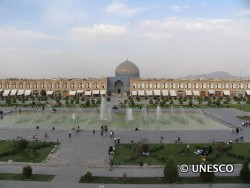 Naqsh-e Jahan Square
Naqsh-e Jahan Square
Built by Shah Abbas I the great at the beginning of th 17th century, and bordered on all sided by monumental buildings linked by a series of two- storied arcades, the site is known for the Royal Mosque, the Mosque of Sheykh Lotfollah, the magnificent Portico of Qaysariyyeh and the 15th century Timurid palace. They are an impressive testimony to the level of social and cultural life in Persia during the Safavid era.
 Persepolis
Persepolis
Founded by Darius I in 518 B.C., Persepolis was the capital of the Achaemenid Empire. It was built on an immense half- artificial, half- natural terrace, where the king of kings created an impressive palace complex inspired by Mesopotamian models. The importance and quality of the monumental ruins make it a unique archaeological Site.
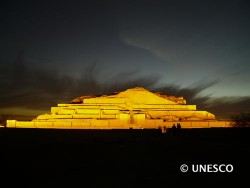 Chogha Zanbil
Chogha Zanbil
The ruins of the holy city of the kingdom of Elam, surrounded by three huge concentric walls, are found at chogha Zanbil. Founded in 1250 B.C., the city remained unfinished after it was invaded by Ashurbanipal, as shown by the thousands of unused bricks left at the site.
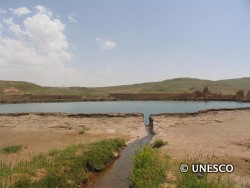 Takht-e-Soleyman
Takht-e-Soleyman
The archaeological site of Takht-e-Soleyman, in north-western Iran, is situated in a valley set in a volcanic mountain region. The site includes the principal Zoroastrian sanctuary partly rebuilt in the Ilkhanid (Mongol) period (13th century) as well as a temple of the Sasanid period (6th and 7th centuries) dedicated to Anahita. The site has important symbolic significance. The designs of the fire temple, the palace and the general layout have strongly influenced the development of Islamic architecture.
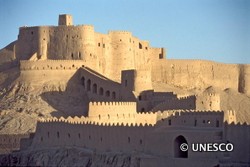 Bam and its cultural Landscape
Bam and its cultural Landscape
Bam is situated in the desert region on the southern edge of the Iranian high plateau. The origins of Bam can be traced back to the Achaemenid period (6th to 4th centuries BC). Its heyday was from the 7th to 11th centuries, being at the crossroads of important trade routes and known for the production of silk and cotton garments. The existence of life in the oasis was based on the underground irrigation canals, the qanats, of which Bam has preserved some of the earliest evidence in Iran. Arg-e Bam is the most representative example of a fortified medieval town built in vernacular technique using mud layers (Chineh).
Pasargadae
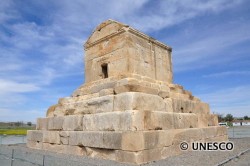 Pasargadae was the first dynastic capital of the Achaemenid Empire, founded by Cyrus II the great, in Pars, homeland of the Persians, in the 6th century BC. Its palaces, gardens and the mausoleum of Cyrus are outstanding examples of the first phase of royal Achaemenid art and architecture and exceptional testimonies of Persian civilization. Particularly noteworthy vestiges include: the Mausoleum of Cyrus II; Tall-e Takht, a fortified terrace; and a royal ensemble of gatehouse, audience hall, residential palace and gardens. Pasargadae was the capital of the first great multicultural empire in western Asia. Spanning the Eastern Mediterranean and Egypt to the Hindus River, it is considered to be the first empire that respected the cultural diversity of its different peoples. This was reflected in Achaemenid architecture, a synthetic representation of different cultures.
Pasargadae was the first dynastic capital of the Achaemenid Empire, founded by Cyrus II the great, in Pars, homeland of the Persians, in the 6th century BC. Its palaces, gardens and the mausoleum of Cyrus are outstanding examples of the first phase of royal Achaemenid art and architecture and exceptional testimonies of Persian civilization. Particularly noteworthy vestiges include: the Mausoleum of Cyrus II; Tall-e Takht, a fortified terrace; and a royal ensemble of gatehouse, audience hall, residential palace and gardens. Pasargadae was the capital of the first great multicultural empire in western Asia. Spanning the Eastern Mediterranean and Egypt to the Hindus River, it is considered to be the first empire that respected the cultural diversity of its different peoples. This was reflected in Achaemenid architecture, a synthetic representation of different cultures.
Soltaniyeh
 The mausoleum of Oljeytu was constructed in 1302-12 in the city of Soltaniyeh, the capital of the Ilkhanid dynasty, which was founded by the Mongols. Situated in the province of Zanjan, Soltaniyeh is one of the outstanding examples of the achievement of Persian architecture and a key monument in the development of its Islamic architecture. The octagonal building is crowned with a 50m tall dome covered in turquoise- blue faience and surrounded by eight slender minarets. It is the earliest existing example of the double-shelled dome in Iran. The mausoleum's interior decoration is also outstanding and scholars such as A.U. pope have described the building as 'anticipating the Taj Mahal'.
The mausoleum of Oljeytu was constructed in 1302-12 in the city of Soltaniyeh, the capital of the Ilkhanid dynasty, which was founded by the Mongols. Situated in the province of Zanjan, Soltaniyeh is one of the outstanding examples of the achievement of Persian architecture and a key monument in the development of its Islamic architecture. The octagonal building is crowned with a 50m tall dome covered in turquoise- blue faience and surrounded by eight slender minarets. It is the earliest existing example of the double-shelled dome in Iran. The mausoleum's interior decoration is also outstanding and scholars such as A.U. pope have described the building as 'anticipating the Taj Mahal'.
Bisotun
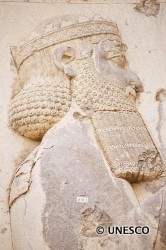 Bisotun is located along the ancient trade route linking the Iranian high plateau with Mesopotamia and features remains from the prehistoric times to the Median, Achaemenid, Sassanian, and Ilkhanid periods. The principal monument of this archaeological site is the bas-relief and cuneiform inscription ordered by Darius I, the great, when he rose to the throne of the Persian Empire, 521 B.C. The bas- relief portrays Darius holding a bow, as a sign of sovereignty, and treading on the chest of a figure that lies on his back before him. According to legends, the figure represents Gaumata, the Median Magus and pretender to the throne whose assassination led to Darius's rise to power. Below and around the bas- reliefs, there are ca.1.200 lines of inscription telling the story of the battles Darius waged in 521-520 BC against the governors who attempted to take a part the Empire founded by Cyrus. The inscription is written in three languages. The oldest is an Elamite text referring to legends describing the king and the rebellions. This is followed by a Babylonian version of similar legends. The last phase of the inscription is particularly important, as it is here that Darius introduced for the first time the Old Persian version of his res gestae (things done). This is the only known monumental text of the Achaemenids to document the re- establishment of the empire by Darius I. it also bears witness to the interchange of influences in the development of monumental art and writing in the region of the Persian empire. There are also remains from the Median period (8th to 7th centuries B.C.) as well as from the Achaemenid (6th to 4th centuries B.C.) and post-Achaemenid periods edge of the Iranian high plateau.
Bisotun is located along the ancient trade route linking the Iranian high plateau with Mesopotamia and features remains from the prehistoric times to the Median, Achaemenid, Sassanian, and Ilkhanid periods. The principal monument of this archaeological site is the bas-relief and cuneiform inscription ordered by Darius I, the great, when he rose to the throne of the Persian Empire, 521 B.C. The bas- relief portrays Darius holding a bow, as a sign of sovereignty, and treading on the chest of a figure that lies on his back before him. According to legends, the figure represents Gaumata, the Median Magus and pretender to the throne whose assassination led to Darius's rise to power. Below and around the bas- reliefs, there are ca.1.200 lines of inscription telling the story of the battles Darius waged in 521-520 BC against the governors who attempted to take a part the Empire founded by Cyrus. The inscription is written in three languages. The oldest is an Elamite text referring to legends describing the king and the rebellions. This is followed by a Babylonian version of similar legends. The last phase of the inscription is particularly important, as it is here that Darius introduced for the first time the Old Persian version of his res gestae (things done). This is the only known monumental text of the Achaemenids to document the re- establishment of the empire by Darius I. it also bears witness to the interchange of influences in the development of monumental art and writing in the region of the Persian empire. There are also remains from the Median period (8th to 7th centuries B.C.) as well as from the Achaemenid (6th to 4th centuries B.C.) and post-Achaemenid periods edge of the Iranian high plateau.
Armenian Monastic Ensembles of Iran
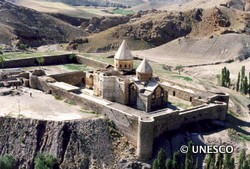 The Armenian Monastic Ensembles of Iran, in the north-west of the country, consists of three monastic ensembles of the Armenian Christian faith: St Thaddeus and St Stephan's and the Chapel of Dzordzor. These edifices- the oldest of which, St Thaddeus, dates back to the 7th century – are examples of outstanding universal value of the Armenian architectural and decorative traditions. They bear testimony to very important interchanges with the other regional cultures, in particular the Byzantine, Orthodox and Persian. Situated on the south-eastern fringe of the main zone of the Armenian cultural space, the monasteries constituted a major centre for the dissemination of that culture in the region. They are the last regional remains of this culture that are still in a satisfactory state of integrity and authenticity. Furthermore, as places of pilgrimage, the monastic ensembles are living witnesses of Armenian religious traditions through the centuries.
The Armenian Monastic Ensembles of Iran, in the north-west of the country, consists of three monastic ensembles of the Armenian Christian faith: St Thaddeus and St Stephan's and the Chapel of Dzordzor. These edifices- the oldest of which, St Thaddeus, dates back to the 7th century – are examples of outstanding universal value of the Armenian architectural and decorative traditions. They bear testimony to very important interchanges with the other regional cultures, in particular the Byzantine, Orthodox and Persian. Situated on the south-eastern fringe of the main zone of the Armenian cultural space, the monasteries constituted a major centre for the dissemination of that culture in the region. They are the last regional remains of this culture that are still in a satisfactory state of integrity and authenticity. Furthermore, as places of pilgrimage, the monastic ensembles are living witnesses of Armenian religious traditions through the centuries.
Shushtar Historical Hydraulic System
 Shushtar, Historical Hydraulic System, inscribed as a masterpiece of creative genius, can be traced back to Darius the great in the 5th centuryB.C. It involved the creation of two main diversion canals on the river Karun one of which, Gargar canal, is still in use providing water to the city of Shushtar via a series of tunnels that supply water to mills. It forms a spectacular cliff from which water cascades into a downstream basin. It then enters the plain situated south of the city where it has enabled the planting of orchards and farming over an area of 40.000 ha Known as Mianab (Paradise). The property has an ensemble of remarkable sites including the Salasel Castel, the operation center of the entire hydraulic system, the tower where the water level is measured, damns, bridges, basins and mills. It bears witness to the know-how of the Elamites and Mesopotamians as well as more recent Nabatean expertise and Roman building influence.
Shushtar, Historical Hydraulic System, inscribed as a masterpiece of creative genius, can be traced back to Darius the great in the 5th centuryB.C. It involved the creation of two main diversion canals on the river Karun one of which, Gargar canal, is still in use providing water to the city of Shushtar via a series of tunnels that supply water to mills. It forms a spectacular cliff from which water cascades into a downstream basin. It then enters the plain situated south of the city where it has enabled the planting of orchards and farming over an area of 40.000 ha Known as Mianab (Paradise). The property has an ensemble of remarkable sites including the Salasel Castel, the operation center of the entire hydraulic system, the tower where the water level is measured, damns, bridges, basins and mills. It bears witness to the know-how of the Elamites and Mesopotamians as well as more recent Nabatean expertise and Roman building influence.